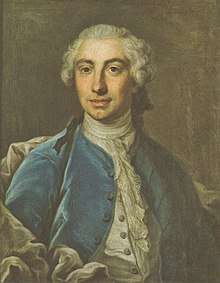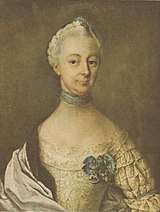Jens Krag-Juel-Vind
Jens Krag-Juel-Vind (15 June 1724 – 30 April 1776), Baron of Juellinge, was a Danish nobleman, Supreme Court justice and landowner. [1]
Jens Krag-Juel-Vind | |
|---|---|
 | |
| Born | 15 June 1624 Halsted Priory, Denmark |
| Died | 30 April 1776 (aged 51) Juellinge, Denmark |
| Resting place | Halsted Church |
| Nationality | Danish |
| Alma mater | University of Hannover University of Copenhagen |
| Occupation | Supreme Court justice, landowner |
| Spouse(s) | Sophie Magdalene von Gram |
Early life and education
He was born at Juellinge (now Halsted Priory), the son of Jens Juel-Vind (1694-1726) and Ide Helle Margaretha, Baroness Krag (1697-1738). He had two sisters. His father died when he was just two years old and Juellinge was then managed by his maternal uncle Niels Juel Reedtz (1699-1742) of Palsgaard and by Joachim Gersdorff. Krag-Juel-Vind studied at the University of Hannover from 1741 and at the University of Copenhagen from 1743. [2][3]
Career
He served as an accessor in the Danish Chancellery from 1745 to 1756. On 17 October 1746, he was appointed as squire (kammerjunker). From 11 February 1747, he held a seat at the Supreme Court without access to vote. From 2 January 1750, he served as Supreme Court justice. On 30, October 1756, he was appointed as chamberlain (kammerherre).[4]
He was less active as Supreme Court justice from 1764 but voted for the last time on 23 December 1771. From 27 October 1756 to 16 December 1769, he served as governor (amtmand) of Copenhagen County. He was a member of the Royal Copenhagen Shooting Society from 1766. In 1764, he was awarded the Ordre de l'Union Parfaite. He was made a knight in the Order of the Danneborg in 1766. [5][6]
In 1769-1774, he was a member of a commission regarding the extra taxes in Copenhagen. In 1769-1771, he served as justitiarius at the Supreme Court. In 1772, he was one of nine judges in the trial of royal physician Johann Friedrich Struensee (1737–1772). On 14 May that same year he was appointed as provisor for Vallø Castle. In 1773, he became a member of the Executive Board (Overskattedirektionen). On 13 July 1774, he became curator for Vemmetofte Adelige Kloster. On 21 October 1774, he was appointed as Privy Councilor (gehejmekonferensråd). On 30 August 1771, he was granted a patent on the surname Krag-Juel-Vind and the associated coat of arms. He served as chief legal officer for the Danish Asiatic Company from 1775. On 25 May 1780, he became a member of the Law Revision Commission.[7]
Property
Upon the death of his father in 1726, he succeeded as the holder of the Barony of Juellinge. In 1738, he also inherited the estate ( stamhuset) of Stensballegaard at Horsens following the death of his mother, Ida Helle Margarethe Krag.[8]
Personal life and legacy

He married Sophie Magdalene von Gram (1734-1810) on 6 April 1752 in Christiansborg Chapel in Copenhagen. She was the daughter of Carl Christian von Gram (1703-1780) and Birgitte Christiane Frijss (1715–75). Her father was the Danish chief of magistrates. [9]
They had six children of which only three survived to adulthood:
- Frederik Carl Krag-Juel-Vind-Frijs (9 January 1753 -10 April 1815)
- Sophie Magdalene Krag-Juel-Vind (4 July 1754 - 9 February 1833)
- Jens Carl Krag-Juel-Vind-Arenfeldt (12 October 1767 - 12 August 1855)
During the 1750s, Krag-Juel-Vind and his wife donated an altarpiece and a canopy for the baptismal font to Halsted Church. Both feature their coats of arms and are still present in the church. In 1751, they financed a refurbishment of the church.[10]
Jens Krag-Juel-Vind died on 30 April 1776 at Juellinge. He was buried on 16 May in the Juel burial chapel at Halsted Church. His marble sarcophagus by neoclassical sculptor, Johannes Wiedewelt (1731–1802), was transferred to Uth Church in 1802.[11] [12]
Ancestry
| Ancestors of Jens Krag-Juel-Vind | ||||||||||||||||||||||||||||||||||||||||||||||||||||||||||||||||||||||||||||||||||||||||||||||||||||||||||||||||||||||||||||||||||||||||||||||||||||||||||||||||||||||||||||||||||||||||||||||||||||||||||||||||||||||||||||||||||||||||||||||||||||||||||||||||||||||||||||||||||||||||||||||||||||||||||||||||||||||||||||||||||||||||||||||||||||||||||||||||||||||||||||||||||||||||||||||||||||||||||||||||||||||||||||||||||||||||||||||||||||||||||||||||||||||||||||||||||||||||||||||||||||||||||||||||||||||||||||||||||||||||||||||||||||||||||||||||||||||||||||||||||||||||||||||||||||||||||||||||
|---|---|---|---|---|---|---|---|---|---|---|---|---|---|---|---|---|---|---|---|---|---|---|---|---|---|---|---|---|---|---|---|---|---|---|---|---|---|---|---|---|---|---|---|---|---|---|---|---|---|---|---|---|---|---|---|---|---|---|---|---|---|---|---|---|---|---|---|---|---|---|---|---|---|---|---|---|---|---|---|---|---|---|---|---|---|---|---|---|---|---|---|---|---|---|---|---|---|---|---|---|---|---|---|---|---|---|---|---|---|---|---|---|---|---|---|---|---|---|---|---|---|---|---|---|---|---|---|---|---|---|---|---|---|---|---|---|---|---|---|---|---|---|---|---|---|---|---|---|---|---|---|---|---|---|---|---|---|---|---|---|---|---|---|---|---|---|---|---|---|---|---|---|---|---|---|---|---|---|---|---|---|---|---|---|---|---|---|---|---|---|---|---|---|---|---|---|---|---|---|---|---|---|---|---|---|---|---|---|---|---|---|---|---|---|---|---|---|---|---|---|---|---|---|---|---|---|---|---|---|---|---|---|---|---|---|---|---|---|---|---|---|---|---|---|---|---|---|---|---|---|---|---|---|---|---|---|---|---|---|---|---|---|---|---|---|---|---|---|---|---|---|---|---|---|---|---|---|---|---|---|---|---|---|---|---|---|---|---|---|---|---|---|---|---|---|---|---|---|---|---|---|---|---|---|---|---|---|---|---|---|---|---|---|---|---|---|---|---|---|---|---|---|---|---|---|---|---|---|---|---|---|---|---|---|---|---|---|---|---|---|---|---|---|---|---|---|---|---|---|---|---|---|---|---|---|---|---|---|---|---|---|---|---|---|---|---|---|---|---|---|---|---|---|---|---|---|---|---|---|---|---|---|---|---|---|---|---|---|---|---|---|---|---|---|---|---|---|---|---|---|---|---|---|---|---|---|---|---|---|---|---|---|---|---|---|---|---|---|---|---|---|---|---|---|---|---|---|---|---|---|---|---|---|---|---|---|---|---|---|---|---|---|---|---|---|---|---|---|---|---|---|---|---|---|---|---|---|---|---|---|---|---|---|---|---|---|---|---|---|---|---|---|---|---|---|---|---|---|---|---|---|---|---|---|---|---|---|---|---|---|---|---|---|---|---|---|---|---|---|---|---|---|---|---|---|---|---|---|---|---|---|---|---|---|---|---|---|---|---|---|---|---|---|---|---|---|---|---|---|---|---|---|---|---|---|---|---|---|---|---|---|---|---|---|---|---|---|---|---|---|---|---|---|---|---|---|---|---|---|---|---|---|---|---|---|---|---|---|---|---|---|---|---|---|---|---|---|---|---|---|---|---|---|---|---|---|---|---|---|---|---|---|
| ||||||||||||||||||||||||||||||||||||||||||||||||||||||||||||||||||||||||||||||||||||||||||||||||||||||||||||||||||||||||||||||||||||||||||||||||||||||||||||||||||||||||||||||||||||||||||||||||||||||||||||||||||||||||||||||||||||||||||||||||||||||||||||||||||||||||||||||||||||||||||||||||||||||||||||||||||||||||||||||||||||||||||||||||||||||||||||||||||||||||||||||||||||||||||||||||||||||||||||||||||||||||||||||||||||||||||||||||||||||||||||||||||||||||||||||||||||||||||||||||||||||||||||||||||||||||||||||||||||||||||||||||||||||||||||||||||||||||||||||||||||||||||||||||||||||||||||||||
References
- Jon Gunnar Arntzen. "Krag-Juel-Vind-Frijs". Store norske leksikon. Retrieved April 1, 2019.
- "Palsgaard". danskeherregaarde. Retrieved April 1, 2019.
- Leon Jespersen. "Joachim Gersdorff". Den Store Danske, Gyldendal. Retrieved April 1, 2019.
- "Lensbaron Jens Krag-Juel-Vind, til baroniet uellinge". finnholbek.dk (in Danish). Retrieved 20 October 2018.
- "Ordenen de l'Union Parfaite". Danish Orders. Retrieved April 1, 2019.
- "The Order of Dannebrog". Danish Orders. Retrieved April 1, 2019.
- "Johann Friedrich Struensee". Rosenborg. Retrieved April 1, 2019.
- "Stensballegaard". danskeherregaarde. Retrieved April 1, 2019.
- P. Chr. Nielsen. "Carl Christian v. Gram". Dansk Biografisk Leksikon Gyldendal. Retrieved April 1, 2019.
- "Halsted klosterkirke". nordenskirker. Retrieved April 1, 2019.
- Hakon Lund. "Johannes Wiedewelt". Kunstindeks Danmark & Weilbach Kunstnerleksikon. Retrieved April 1, 2019.
- "Uth Church". visitdenmark.com. Retrieved April 1, 2019.
External links
| Wikimedia Commons has media related to Jens Krag-Juel-Vind. |